 One of my favorite things to do is natural dying on wool fabric I use in my quilts, but this year, I am also dying wool yarn to use when I go to New Mexico in Sept. and spend a week on the Navajo reservation learning to weave from Sarah Natani, an elderly Navajo woman that has been having workshops on her sheep ranch for many years. My husband and I both will be learning to weave the "Navajo" way. I've been researching it and I'm not sure a week will be enough time to learn!
One of my favorite things to do is natural dying on wool fabric I use in my quilts, but this year, I am also dying wool yarn to use when I go to New Mexico in Sept. and spend a week on the Navajo reservation learning to weave from Sarah Natani, an elderly Navajo woman that has been having workshops on her sheep ranch for many years. My husband and I both will be learning to weave the "Navajo" way. I've been researching it and I'm not sure a week will be enough time to learn!
(pictures are reversed, I'm still learning this Blog thing!)
I began this spring dying with the daffodils in my yard and my employees yard. The wool fabric on the right was dyed from them. The fabric and wool yarn to the left were dyed from dandelions (I have a good crop of them in my yard). The yarn is a wonderful chartreuse, it is 85% wool and 15% mohair and grabs the dye wonderfully and more quickly than the wool fabric.
The rust color wool was dyed from onion skins, the lighter color (fabric and yarn) I dyed in early spring, the darker, rust color was dyed recently with Vadalia onion skins. The last fabric to the left is cotton. I get a much deeper color with wool (I use Alum for mordant, there are much better mordants for cotton).

 My hand-carved stamps which we use for the class. Pine needles from Africa which we use to splash little spots of wax on.
My hand-carved stamps which we use for the class. Pine needles from Africa which we use to splash little spots of wax on. Ernestine applying wax to her fabric.
Ernestine applying wax to her fabric. Beth putting her waxed fabric in its first dye pot.
Beth putting her waxed fabric in its first dye pot. Debra doing a African technique called squeezing with squitters fill with left over dye.
Debra doing a African technique called squeezing with squitters fill with left over dye. Some of the steps to batik fabric, white fabric with 1st. wax, dyed with green, waxed again and dyed with blue, then wax boiled out.
Some of the steps to batik fabric, white fabric with 1st. wax, dyed with green, waxed again and dyed with blue, then wax boiled out.






 Batik sampler. This quilt is a sampler of many of my hand carved stamps. I dyed the lattice strips at the same time as I was batiking.
Batik sampler. This quilt is a sampler of many of my hand carved stamps. I dyed the lattice strips at the same time as I was batiking.















